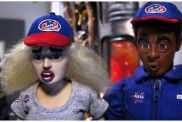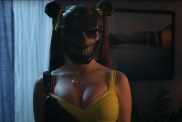
Hara-Kiri: Death of a Samurai, Takashi Miike’s new adaptation of Yasuhiko Takiguchi’s novel, is an absolute snoozer. Somehow he has managed to make a film six minutes shorter than Masaki Kobayashi’s far superior 1962 classic and make it feel as if it is one hour longer. Miike’s telling is incredibly similar to that of Kobayashi’s, the difference being Miike’s inability to break free of his lethargic pace. With a running time set at two hours and six minutes, it’s the 90 minutes smack dab in the middle that test your ability to stay awake.
Hara-kiri follows the fractured narrative of Hanshiro (Ebizo Ichikawa), an unemployed samurai who sets out to exact revenge on the House of Ii after learning of the fate of his son-in-law Motome (Eita) in the house’s courtyard two months earlier. The film bounces back-and-forth in time to tell its story and create an increasing amount of tension, but Miike’s decision to tell the back-story that led to Hanshiro’s arrival at the House’s gate in one lengthy segment midway through is a massive miscalculation, turning the film into a dreadful bore.
Serving as the polar opposite to Miike’s recent samurai effort, 13 Assassins, which was an absolute blast and a modern day samurai feature worth owning, Hara-kiri is slow and deliberate to a fault. The tension is found in the reason Hanshiro has brought himself to the House of Ii and why three of their samurai have gone missing. As heart-wrenching as the story of Motome and his sick wife and child — which brought him to the House of Ii in the first place — is, Miike drags their story out so long you find yourself hoping they will die just so something else can happen.
Additionally, the message relating to the honor and the code of the samurai isn’t as powerful as it need be. Miike doesn’t establish the current poverty level the samurai are facing will enough, as the result of peace in Edo, causing for scores of unemployed ronin. The words and moments are there, but the passion doesn’t come through.
The mood is also thrown off by the more modern score from Ryuichi Sakamoto, the Oscar-winning composer of Bernardo Bertolucci’s The Last Emperor. Sakamoto’s score itself isn’t the problem, it’s actually wonderful music, it just doesn’t fit as much as it lulls you to sleep.
The 3D was another miscalculation as it brings absolutely nothing to the story outside of turning it into a dark and murky mess. As much as I despise 3D, I like to think I’ve been relatively fair to the gimmicky filmmaking technique, but this is inexcusable. Even in the press notes Miike says he did nothing different when shooting with 3D than he would have with 2D. Then why do it? If 3D is going to work, shots need to be framed differently. The impressive set used for the House of Ii includes some rooms and corridors, not to mention the courtyard, which could have brought the audience deeper into the feature, but as it stands it took me out of it as I was left to constantly fidget with my glasses, trying my hardest to stay awake.
The biggest problem for me was the lackluster climax. This isn’t a samurai film in the sense you may be thinking. It isn’t a film filled with swords clashing, geysers of blood and slain combatants. It’s more of a courtroom drama in fact, but the story does include moments for action and Miike dismisses them believing his final set piece will suffice. It doesn’t.
Changes from Kobayashi’s film at the beginning and end were distracting as they weren’t changes for the better, but they still could have worked if this hadn’t been such a butt-numbing slog. Unless it is entirely re-edited, this is a film to skip. The middle 90 minutes need a serious overhaul, and I just wonder if Miike will take the time to do it before he quickly moves to his next project.








